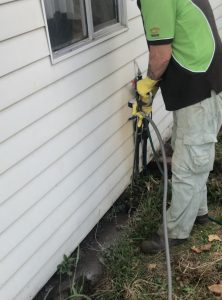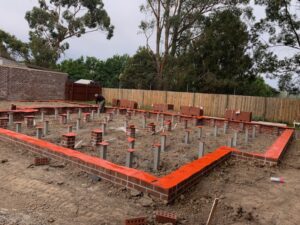When it comes to termite protection, termite barriers are frequently mentioned. But what are termite barriers, and do you need one?
In simple terms, most people would view a termite barrier as something that termites cannot get past. So, by applying a termite barrier around a home, it prevents termites from entering the building and thus protecting the home. However, there are a range of different products that fit this description and so termite professionals in the pest control industry don’t often use the term, “termite barrier”.
Chemical termite barriers

The main way to protect homes from termite attack (especially existing buildings) is to get a termite treatment to apply a chemical to the soil around and under the building with chemicals (insecticide). Many of the older chemicals used for these treatments were repellent to termites. Termites approach the treated soil were repelled by the chemical, effectively making a chemical termite barrier. It was this type of treatment, with this type of chemical which probably gave rise to the term, termite barrier.
However, many of the newer chemicals used to treat the soil, such as Termidor, are non-repellent. Termites cannot detect their presence and when they try entering the treated soil, they contact the insecticide and die. Over the years, pest professionals have stopped using the phrase termite barrier and now call the treated soil, simply a “treated zone”.
Do you need one? For existing buildings without suitable termite protection measures, getting a liquid soil termite treatment to create a treated zone around and under the building is the most common way to protect a house from termite attack.
Physical termite barriers

Physical termite barriers are products that are used during the construction of a building or during renovations, to provide termite protection. They are used to plug any gaps in the construction that could allow access for the termites to enter the building and start feeding on the wood. In many ways, it would be correct to call these products termite barriers. But as there are many different types of products for different situations, they are more commonly described by their product name, rather than using the term, termite barrier.
A common physical termite barrier that most people would be aware of are “ant caps”. These are the metal plates that sit on top of supporting piers under houses, to stop termites crawling up inside the pier to access the timber floor supports. Houses on piers provide the benefit that you can actually crawl underneath the building to see if any termites are trying to get in. For houses built on concrete slabs, that obviously isn’t possible.
But for houses built on concrete slabs, there are still utility pipes that have to enter through the slab – water and drainage pipes being the main ones. Where the pipes penetrate the slab provides an easy entry point for termites. As such, these entry points need to be protected when the slab is poured. This is achieved by placing a thick plastic collar around the pipe which gets embedded in the slab, sealing off any potential gaps for termites to enter.
Importantly, most new homes will require some form of termite barrier to be incorporated into the base of the perimeter wall for the same reason. The most common type of barrier is plastic sheeting – thick polypropylene sheeting (which is often impregnated with insecticide), that termites cannot penetrate. Here at Termites VIC, we typically use Kordon for protecting perimeter walls. There are also metal mesh sheeting products, which provide the same benefit.
Hopefully that answers the question as to what termite barriers are? So, yes, you do need one! Whether you’re building a home or carrying out a renovation, or need to protect and existing home, please give us a call at Termites VIC for advice and a FREE quote.
